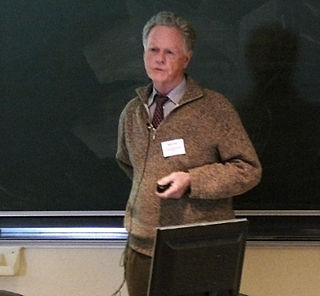Related Research Articles

Discrete mathematics is the study of mathematical structures that are fundamentally discrete rather than continuous. In contrast to real numbers that have the property of varying "smoothly", the objects studied in discrete mathematics – such as integers, graphs, and statements in logic – do not vary smoothly in this way, but have distinct, separated values. Discrete mathematics therefore excludes topics in "continuous mathematics" such as calculus or Euclidean geometry. Discrete objects can often be enumerated by integers. More formally, discrete mathematics has been characterized as the branch of mathematics dealing with countable sets. However, there is no exact definition of the term "discrete mathematics." Indeed, discrete mathematics is described less by what is included than by what is excluded: continuously varying quantities and related notions.
Fuzzy logic is a form of many-valued logic in which the truth values of variables may be any real number between 0 and 1 both inclusive. It is employed to handle the concept of partial truth, where the truth value may range between completely true and completely false. By contrast, in Boolean logic, the truth values of variables may only be the integer values 0 or 1.

The theory of belief functions, also referred to as evidence theory or Dempster–Shafer theory (DST), is a general framework for reasoning with uncertainty, with understood connections to other frameworks such as probability, possibility and imprecise probability theories. First introduced by Arthur P. Dempster in the context of statistical inference, the theory was later developed by Glenn Shafer into a general framework for modeling epistemic uncertainty—a mathematical theory of evidence. The theory allows one to combine evidence from different sources and arrive at a degree of belief that takes into account all the available evidence.

Allen Newell was a researcher in computer science and cognitive psychology at the RAND Corporation and at Carnegie Mellon University’s School of Computer Science, Tepper School of Business, and Department of Psychology. He contributed to the Information Processing Language (1956) and two of the earliest AI programs, the Logic Theory Machine (1956) and the General Problem Solver (1957). He was awarded the ACM's A.M. Turing Award along with Herbert A. Simon in 1975 for their basic contributions to artificial intelligence and the psychology of human cognition.
Stochastic refers to a randomly determined process. The word first appeared in English to describe a mathematical object called a stochastic process, but now in mathematics the terms stochastic process and random process are considered interchangeable. The word, with its current definition meaning random, came from German, but it originally came from Greek στόχος (stókhos), meaning 'aim, guess'.
Ray Solomonoff was the inventor of algorithmic probability, his General Theory of Inductive Inference, and was a founder of algorithmic information theory. He was an originator of the branch of artificial intelligence based on machine learning, prediction and probability. He circulated the first report on non-semantic machine learning in 1956.

A neural network is a network or circuit of neurons, or in a modern sense, an artificial neural network, composed of artificial neurons or nodes. Thus a neural network is either a biological neural network, made up of real biological neurons, or an artificial neural network, for solving artificial intelligence (AI) problems. The connections of the biological neuron are modeled as weights. A positive weight reflects an excitatory connection, while negative values mean inhibitory connections. All inputs are modified by a weight and summed. This activity is referred to as a linear combination. Finally, an activation function controls the amplitude of the output. For example, an acceptable range of output is usually between 0 and 1, or it could be −1 and 1.
Imprecise probability generalizes probability theory to allow for partial probability specifications, and is applicable when information is scarce, vague, or conflicting, in which case a unique probability distribution may be hard to identify. Thereby, the theory aims to represent the available knowledge more accurately. Imprecision is useful for dealing with expert elicitation, because:
The aim of a probabilistic logic is to combine the capacity of probability theory to handle uncertainty with the capacity of deductive logic to exploit structure of formal argument. The result is a richer and more expressive formalism with a broad range of possible application areas. Probabilistic logics attempt to find a natural extension of traditional logic truth tables: the results they define are derived through probabilistic expressions instead. A difficulty with probabilistic logics is that they tend to multiply the computational complexities of their probabilistic and logical components. Other difficulties include the possibility of counter-intuitive results, such as those of Dempster-Shafer theory in evidence-based subjective logic. The need to deal with a broad variety of contexts and issues has led to many different proposals.
In decision theory, the evidential reasoning approach (ER) is a generic evidence-based multi-criteria decision analysis (MCDA) approach for dealing with problems having both quantitative and qualitative criteria under various uncertainties including ignorance and randomness. It has been used to support various decision analysis, assessment and evaluation activities such as environmental impact assessment and organizational self-assessment based on a range of quality models.

Gregory Wheeler is an American logician, philosopher, and computer scientist, who specializes in formal epistemology. Much of his work has focused on imprecise probability. He is currently Professor of Philosophy and Computer Science at the Frankfurt School of Finance and Management, and has held positions at LMU Munich, Carnegie Mellon University, the Max Planck Institute for Human Development in Berlin, and the New University of Lisbon. He is a member of the PROGIC steering committee, the editorial boards of Synthese, and Minds and Machines, and was the editor-in-chief of Minds and Machines from 2011 to 2016. He obtained a Ph.D. in philosophy and computer science from the University of Rochester under Henry Kyburg.
Words of estimative probability are terms used by intelligence analysts in the production of analytic reports to convey the likelihood of a future event occurring. A well-chosen WEP gives a decision maker a clear and unambiguous estimate upon which to base a decision. Ineffective WEPs are vague or misleading about the likelihood of an event. An ineffective WEP places the decision maker in the role of the analyst, increasing the likelihood of poor or snap decision making. Some intelligence and policy failures appear to be related to the imprecise use of estimative words.

Applied mathematics is the application of mathematical methods by different fields such as science, engineering, business, computer science, and industry. Thus, applied mathematics is a combination of mathematical science and specialized knowledge. The term "applied mathematics" also describes the professional specialty in which mathematicians work on practical problems by formulating and studying mathematical models.
Quantum cognition is an emerging field which applies the mathematical formalism of quantum theory to model cognitive phenomena such as information processing by the human brain, language, decision making, human memory, concepts and conceptual reasoning, human judgment, and perception. The field clearly distinguishes itself from the quantum mind as it is not reliant on the hypothesis that there is something micro-physical quantum mechanical about the brain. Quantum cognition is based on the quantum-like paradigm or generalized quantum paradigm or quantum structure paradigm that information processing by complex systems such as the brain, taking into account contextual dependence of information and probabilistic reasoning, can be mathematically described in the framework of quantum information and quantum probability theory.

A probability box is a characterization of an uncertain number consisting of both aleatoric and epistemic uncertainties that is often used in risk analysis or quantitative uncertainty modeling where numerical calculations must be performed. Probability bounds analysis is used to make arithmetic and logical calculations with p-boxes.
The following outline is provided as an overview of and topical guide to formal science:
Probability bounds analysis (PBA) is a collection of methods of uncertainty propagation for making qualitative and quantitative calculations in the face of uncertainties of various kinds. It is used to project partial information about random variables and other quantities through mathematical expressions. For instance, it computes sure bounds on the distribution of a sum, product, or more complex function, given only sure bounds on the distributions of the inputs. Such bounds are called probability boxes, and constrain cumulative probability distributions.
This glossary of artificial intelligence is a list of definitions of terms and concepts relevant to the study of artificial intelligence, its sub-disciplines, and related fields. Related glossaries include Glossary of computer science, Glossary of robotics, and Glossary of machine vision.

Romano Scozzafava is an Italian mathematician known for his contributions to subjective probability along the lines of Bruno de Finetti, based on the concept of coherence. He taught Probability Calculus at the Engineering Faculty of the Sapienza University of Rome from 1979 to his retirement.
References
- "On the Use of Imprecise Probabilities in Reliability", F. P. A. Coolen, : 15th ARTS Advances in Reliability Technology Symposium abstract
- Editorial: Imprecise probability perspectives on artificial intelligence by Marco Zaffalon and Gert de Cooman. — Annals of Mathematics and Artificial Intelligence (subscription required)